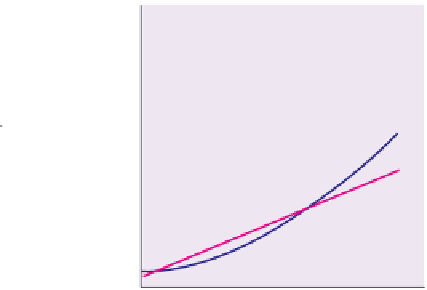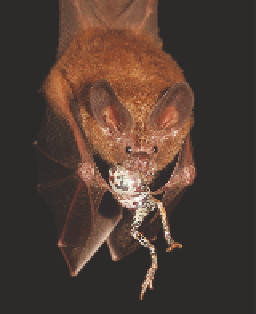Biology Reference
In-Depth Information
(a)
(b)
30
0.20
0.15
20
2
0.10
1
10
0.05
0
0
0
100
200
300
400
0
20
40
60
80
Chorus size
Chorus size
Fig. 9.5
Male frogs,
Physalaemus pustulosus
, aggregate into choruses. In larger choruses individuals are safer
from predatory bats (a). The number of females attracted also increases with chorus size (b). The curve (2) gives
a better fit to the observed points than a straight line (1), which suggests that the number of females per male
increases with chorus size. From Ryan
et al
. (1981). Photo © Alexander T. Baugh.
In many cases, however, females only visit lek sites in order to mate, so the males are
not simply settling in areas the females would visit in the course of their normal daily
routine (e.g. Kafue lechwe,
Kobus lechwe
, an African antelope; Balmford
et al
., 1993).
Furthermore, males are often aggregated far more closely than would be expected from
settlement 'on top' of the female pattern of dispersion.
Males aggregate to reduce predation
In the neotropical frog
Physalaemus pustulosus
, calling males suffer heavy predation by
bats,
Trachops
spp., which home in on the male calls. Calling males are safer in larger
choruses because of the dilution effect (Fig. 9.5a; Chapter 6). However, this is unlikely
to be a general explanation of lekking; in many bird leks predation pressure seems to be
extremely low.
Avoiding
predation
Males aggregate to increase female attraction
Males may gain from 'stimulus pooling'; by displaying together they may provide a
greater attraction for females and draw in mates from a larger distance. To explain the
male aggregation the increase in female attraction would have to be marked, so that
pay-offs per individual male increased with lek size. Figure 9.5b suggests this is true for
the frog
Physalaemus
, but the relationship may merely reflect the fact that larger
choruses form in areas where females are more abundant anyway. An experimental
approach is needed to test whether larger choruses
cause
greater female attraction. Todd
Shelly (2001) varied lek size experimentally in two species of tephritid flies, where males
aggregate on leaves and emit pheromones or acoustic signals to attract females. He
placed varying numbers of males in small pots covered with mesh and then released
hundreds of females nearby to see how many were attracted to each lek. In one species,
Synergistic
displays










































































































